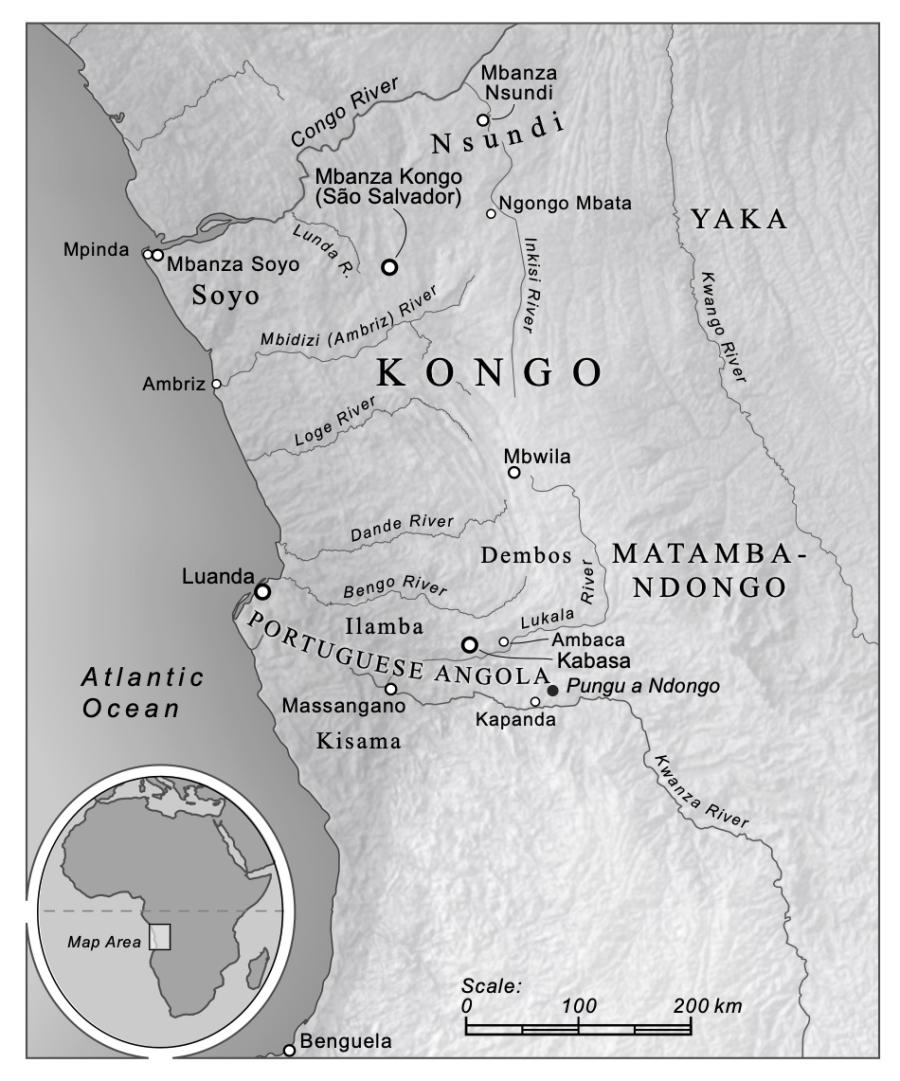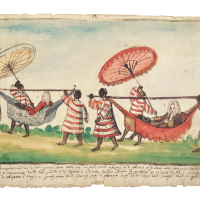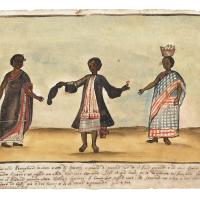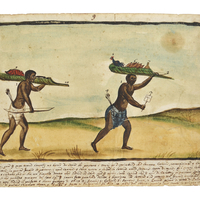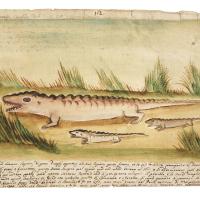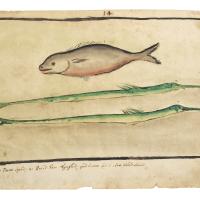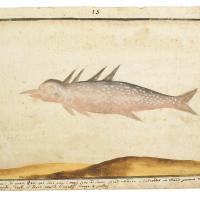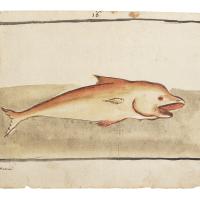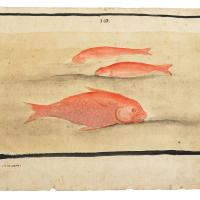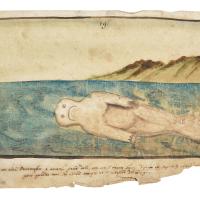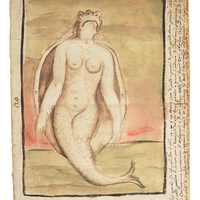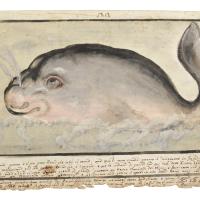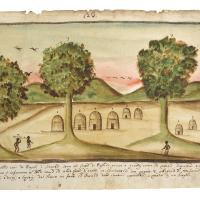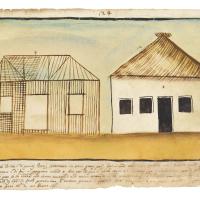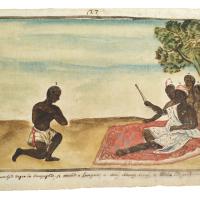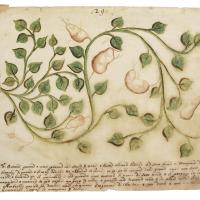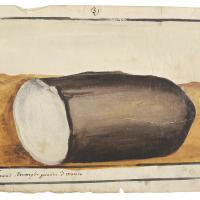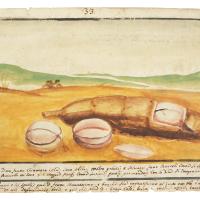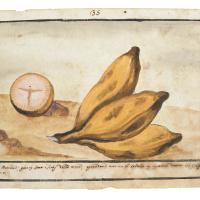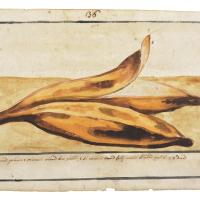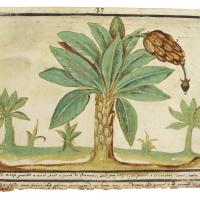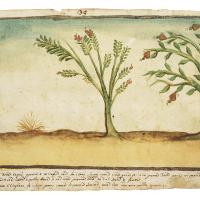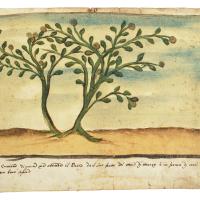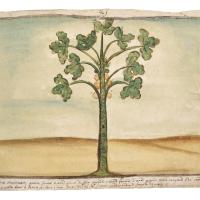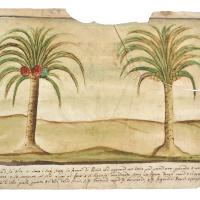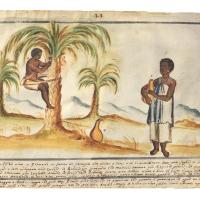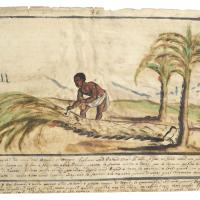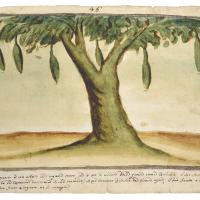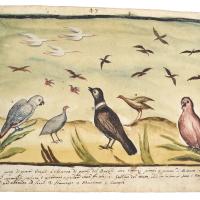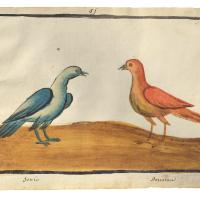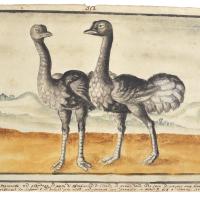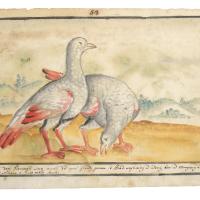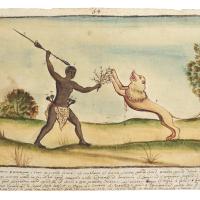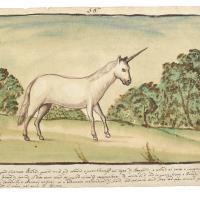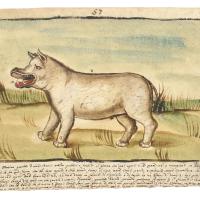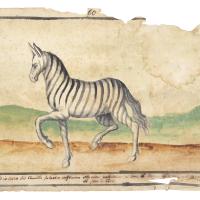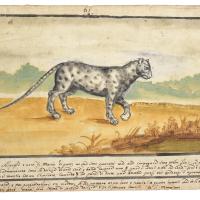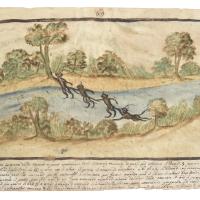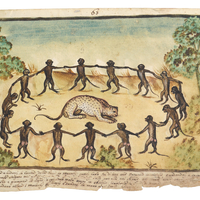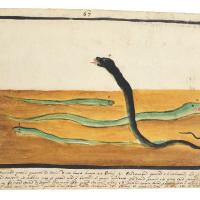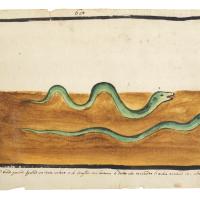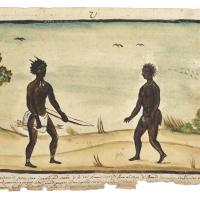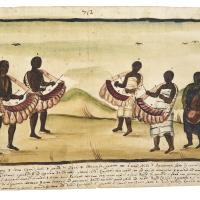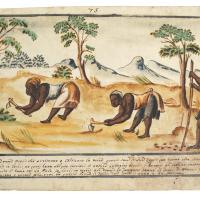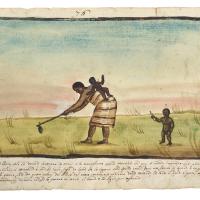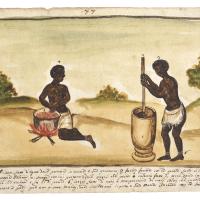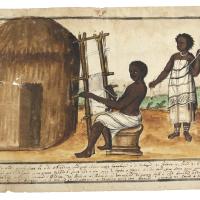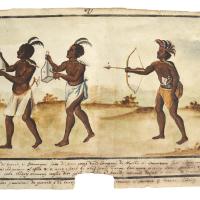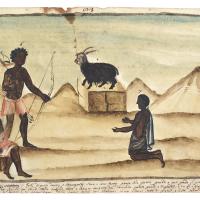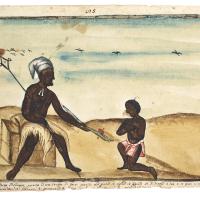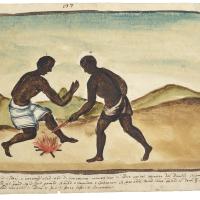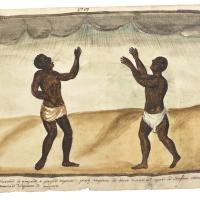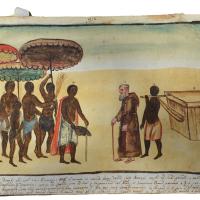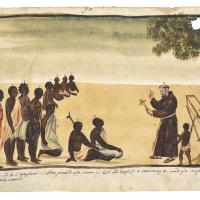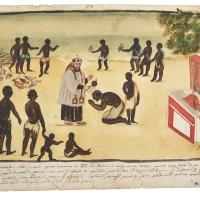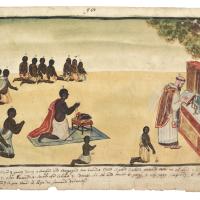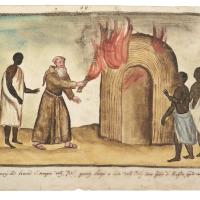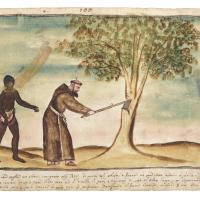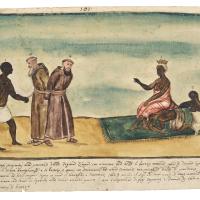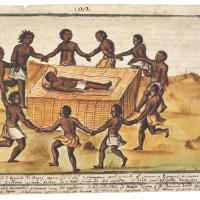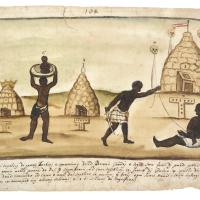Cécile Fromont is Professor of the History of Art department at Yale University. She is the author of The Art of Conversion: Christian Visual Culture in the Kingdom of Kongo (University of North Carolina Press and Omohundro Institute, 2014) and Images on a Mission in Early Modern Kongo and Angola (Penn State Press, 2022). She also edited and contributed to the 2019 volume Afro-Catholic Festivals in the Americas: Performance, Representation, and the Making of Black Atlantic Tradition (Penn State Press – Africana Religions Series). Her writing and teaching focus on the visual, material, and religious culture of Africa and Latin America with a special emphasis on the early modern period (ca. 1500-1800), on the Portuguese-speaking Atlantic World, and on the slave trade.
Introduction to the Corpus
An African ruler dressed in the finery of a cosmopolitan, fashionable man of the late seventeenth-century welcomes a Capuchin friar to his town.1 (PW092) A man and two attendants worship a live goat standing on a pedestal. (PW083) Eight carefully depicted birds occupy a spare landscape. (PW047) Early modern central Africa comes to life in the images that Capuchin friars—veterans of the Kongo and Angola missions—composed between 1650 and 1750 for the guidance of future missionaries. Their vivid full-page paintings, glossed with a few lines of text, present the intricacies of the natural, social, and religious landscape of seventeenth- and eighteenth-century west central Africa, a region in today’s western Democratic Republic of Congo and northern Angola (Fig. 1). In vignettes emulating the format of scientific illustrations, costume books, and even map cartouches, the friars depicted animals and plants, described central African cultural and religious practices, and detailed the primarily visual catechization methods they created for the parishes and new missions of a region whose inhabitants, at the time of the paintings, had already engaged of the paintings had engaged with the visual and material culture of Europe and Christianity for more than one hundred and fifty years.
- 1Research and writing for this Essay have been supported by a Berenson Fellowship from I Tatti – The Harvard Center for Italian Renaissance Studies, an American Academy Rome Prize, a Yale Institute for Sacred Music Fellowship, and a Paul Oskar Kristeller Fellowship from the Renaissance Society of America. Support for the digital format of the essay comes from the Yale Faculty of Arts and Sciences. I am grateful for the support and encouragement from the Virgili and Araldi families over the years in my study of the manuscripts in their collections. Gaston Javier Basile, Giacomo Berchi, Veronica Copello, Erin Griffin, Katharina Natalia Piechocki have helped me in small and big ways with the paleography and translation. Thank you to John Thornton for his positive review of the essay. David C. Recksieck and Jim DeGrand are to be credited for the line art and the map, respectively. Sophia Kitlinski, Nathalie Miraval, Bennett Harrison, and Vu Horwitz, offered key research assistance at different stages of the project. Ruby Anderson expertly and patiently took care of the digital upload and formatting of the essay. Still, all errors are mine. Finally my thanks to Emily Floyd for her unwavering support for the project and for her editorial engagement and guidance throughout the process.
Since the late fifteenth century, west central Africans, first the inhabitants of the kingdoms of Kongo, then those of Matamba, Ndongo, and people living under the purview of the Portuguese Conquista of Angola, participated in the commercial and diplomatic networks of the Atlantic World.2 Through trade, diplomatic gifts, and the travels of emissaries from and to the region, central Africans became familiar with, adopted, rejected, or adapted elements of the religious, political, visual, and material culture of Europe, the Americas, and Asia. Elite insignia and personal luxuries included imported fineries such as the showy beaver felt hat worn by the Ndembu ruler in PW092, or the colorful printed cottons draped around men and women of the Kongo and Angola as seen in PW007, PW070, PW098.
When Capuchin friars arrived in the region in 1645 as part of a newly formed mission, they did not find themselves in the distant, foreign land wholly opposite to theirs that they expected to find. They landed instead in a cosmopolitan environment that deeply challenged their preconceptions about Africa and Africans. It was, in fact, the kings of Kongo themselves who had asked the Pope to send the Franciscan clerics, with the aim to ensure their realm’s independence in spiritual but also temporal affairs from the increasingly expansionist Portuguese colonial foothold of Angola, at its southern border. For historical reasons, Portugal claimed control over the Church of the Kongo through the rights of patronage.3 The African crown disagreed and turned directly to Rome to seek clerics outside of the Iberian realm’s control. The Capuchin central African mission emerged from these negotiations. Once in central Africa, the Capuchins not only worked at the demand of the local powers, but they also remained firmly under their control and dependent on their support in all aspects of their mission, from food and shelter to free passage and liturgical practice.
This political context was unusual for an early modern European Catholic mission, which more often functioned within projects of colonial or imperial imposition than at the behest of local powers. This situation often created perplexing social interactions for the friars, in addition to the myriad, unexpected encounters, mediated or unmediated, that they faced with an endlessly surprising array of tropical flora and fauna. In response, they would turn to images to make sense of the wondrous novelties they encountered and the baffling situations they faced, as well as to document the responses they devised to them, in order to educate the friars who would follow them about the proper conduct of the mission in Kongo and Angola. The result of this decades-long reflection, operated collaboratively by a number of friars who often did not wish to be named, following the modesty of their vows, is a set of images that formed a coherent corpus from its first work created in the 1650s, to its last known manuscript penned around 1750.
Today, this Capuchin central African corpus consists of four extant manuscripts connected by form and content. Chronologically, the first is a panel now in the Museo Francescano in Rome (MF00) dated to the 1650s. The second is a set of sixty-seven images that I call the Parma Watercolors likely created circa 1663-1690 (PW002 to PW102). Neither of these two manuscripts have identified authors. Decades later, around 1750, friar Bernardino d’Asti composed two versions of an illustrated manual he titled Missione in Prattica, one of which is today in the Biblioteca Civica di Torino, the other in the Vatican Library.4 The Turin library offers an online version of the manuscript.5 I made available for the first time the integrality of the images from the Vatican Library and the Parma Watercolors in my book Images on a Mission in Early Modern Kongo and Angola, published in 2022 with Penn State University Press.6
The present Essay complements the book, in conjunction with a Collection also in this issue of the MAVCOR Journal placing the images in their broader visual context and laying out points of comparisons between the different works.7 It offers additional visual material from the corpus by featuring details of each individual vignette of the 1650s poster as well as the unpublished versos of the Parma Watercolors that feature text. My 2007 photographs of the Museo Francescano drawing precede its latest conservation and retain parts of images and texts that have since been lost. My 2015 photographs of the Parma Watercolors also document the manuscript in a state of conservation that includes some edges and areas now eroded from the pages.
Readers should turn to Images on a Mission for a discussion of the conception and execution of the Capuchin central African corpus, as well as for an analysis of their projects and of the stakes of their study. In the present essay, they will find my transcription and translation of the images’ text. I present this work not as a translator or a scholar of seventeenth-century Italian language, but as a specialist in the cross-cultural environment of early modern central Africa. Reading these documents in fact demands a particular set of skills that do not pertain wholly to language proficiency. Linguistically, they ebb and flow fluidly between Italian, Portuguese, Latin, Kikongo, and Kimbundu. Intellectually, they draw from and rely on ideas, practices, and political positions that are idiosyncratic to the Capuchin central African mission. Visually, they call upon genres, iconographies, and motifs rooted in early modern European visual culture, to depict objects, practices, and forms of knowledge with deep central African significance. Having researched, written about, and conceptualized the cross-cultural religious, visual, and political environment of central Africa in the early modern period for nearly two decades, with, what is more, special attention to the Capuchin presence and activities in the region, I am uniquely positioned to disentangle the difficulties presented by, and offer insight on, the texts and images. The number and complexity of both images and texts however greatly surpass anyone’s single abilities to make sense of them and note all their multifaceted connections. I have thus collaborated with MAVCOR Journal to include in this essay a comment section for each vignette where insights from readers about the texts and images will, over time, increase understanding of the corpus and its multifaceted contributions to knowledge. I hope that this space will allow for corrections to the transcriptions and translations, paleographic suggestions, object identifications, and complementary citations of primary or secondary sources, in a collaborative, cumulative, publicly available study of this material.
- 2About the term “Conquista” to refer to Portuguese overseas colonial endeavors see Charles Ralph Boxer, Race relations in the Portuguese colonial empire, 1415-1825 (Oxford: Clarendon Press, 1963), 2; Josiah Blackmore, Moorings: Portuguese expansion and the writing of Africa (Minneapolis: University of Minnesota Press, 2009), xxii. For an overview of the history of the region see John K Thornton, A History of West Central Africa to 1850, vol. 14 (Cambridge: Cambridge University Press, 2020).
- 3About the patronage rights see António da Silva Rego, Le patronage portugais de l'orient: aperçu historique (Lisbon: Agencia Geral do Ultramar, 1957); Isabel dos Guimarães Sá, "Ecclesiastical structures and religious action," in Portuguese Oceanic Expansion, 1400–1800, ed. Francisco Bethencourt and Diogo Ramada Curto (New York: Cambridge University Press, 2007).
- 4Bernardino Ignazio da Vezza d'Asti, Missione in prattica. Padri Cappuccini ne' regni di Congo, Angola, et adiacenti., ca 1750, Biblioteca Civica Centrale di Torino, MS 457: 29, Turin; Bernardino Ignazio da Vezza d'Asti, Missione in prattica de RP cappuccini italiani ne regni di Congo, Angola, et adiacenti, ca. 1750, Biblioteca Vaticana, MS Borg. Lat. 316: Vatican Another, non illustrated version of is in Lisbon. Bernardino Ignazio da Vezza d'Asti and Guiseppe Rabagliati, Missione in Pratica de PP. Cappuccini Italiani ne Regni di Congo, Angola, e adiacenti brevemente esposta p: lume, e guida de Missionari a quelle Sante Missioni destinati, ca. 1750, Biblioteca Nacional de Lisboa, MS 1432 FG: Lisboa. About the story of these manuscripts see Cécile Fromont, Images on a Mission in Early Modern Kongo and Angola (University Park: Penn State University Press, 2022), 41-62.
- 5“Missione in Prattica,” Biblioteche Civiche Torinesi, accessed January 9, 2023, available here.
- 6Fromont, Images on a Mission.
- 7Cécile Fromont, "Depicting Kongo and Angola in the Seventeenth and Eighteenth Centuries," MAVCOR Journal 6, no. 1 (2022), available here.
Museo Francescano
“Of the People, Victuals, Customs, Animals, and Fruits of the Kingdoms of Africa penetrated to preach the Gospel by order of the Sacred Congregation for Propaganda Fide by Capuchins in the year of 1644. Congo, Angola, Dongo or Njinga, and Embaca” labels the top of a large-format, ink on paper drawing measuring 73 by 40 cm, inventory number MF 1370 in the Museo Francescano of the Capuchin order’s Historical Institute at the Convent of San Lorenzo da Brindisi in Roma-Bravetta. Capuchin historian Édouard d’Alençon first reported the drawing’s purchase on the Roman antiquarian market around 1900 and its entrance into the collection of what was then the Missions Museum of the San Lorenzo da Brindisi Convent.1 No further mention of the piece exists to my knowledge, until 2011, when I first discussed it in print.9
The page, once folded, perhaps to travel from central Africa to Europe, presents on a single surface 35 individual vignettes of unequal size rendered in black ink to which short textual glosses were added subsequently. Stamped acanthus leaves frame the page with a border of a lighter hue than the drawings. The verso is blank. Images and texts work in concert to offer an ordered compendium of information about Kongo and Angola, from courtly life, to mores and customs, flora and fauna, and missionary prowess. Though not dated, it postdates the depicted violent death of Friar Joris van Gheel in 1652 and predates the death of Queen Njinga of Matamba in 1663, who it discusses as alive.10
A few notes on the following transcription and translation. To facilitate reading, I have labelled each vignette on the page individually with a number from 1 to 35. Each section includes my transcription of the Italian text with original orthography and punctuation, followed by my English translation which I kept purposely close to the source. Missing words or uncertain readings are indicated between brackets. Footnotes inserted in the Italian transcription give further information on particular terms.
- 1Edouard d'Alençon, "Essai de Bibliographie Capucino-Congolaise," Neerlandia Franciscana 1, no. 1 (1914): 261-62.
- 9Cécile Fromont, "Collecting and Translating Knowledge Across Cultures: Capuchin Missionary Images of Early modern Central Africa," in Collecting Across Cultures: Material Exchanges in the Early Modern Atlantic World, ed. Daniela Bleichmar and Peter Mancall (Philadelphia: University of Pennsylvania Press, 2011).
- 10Hildebrandus ab Hooglede, “Le père Georges de Gheel (+1652): Missionnaire, philologue et martyr,“ Études Franciscaines 42, no. 238 (1930). See also biographical information in Graziano M. da Leguzzano Saccardo, Congo e Angola con la storia dell'Antica missione dei Cappuccini, 3 vols. (Venice-Mestre: Curia Povinciale dei Cappuccini, 1982-1983), 1:489-90.
- Arma del Congo
- Court of Garcia II of Kongo
- Provincial Ruler of Kongo
- Justice under the tree
- Men and Women from the Kongo
- Architecture
- Tree [Ficus]
- Palm Tree [unidentified]
- Palm tree with fruit [Elaeis guineensis]
- Coconut tree [Cocos nucifera]
- Raffia [Raphia]
- Niceffo [Musaceae]
- Banana [Musaceae]
- Cross section of niceffo
- Fruit [?]
- Tree [Dracaena draco?]
- Safou [Dacryodes edulis]
- Manioc [Manihot esculenta]
- Yam [Dioscorea]
- Potato [Solanum tuberosum]
- Pineapple [Ananas comosus]
- Peanut [Arachis hypogaea]
- Corn [Zea mays]
- Cooking
- Papaya [Carica papaya]
- Kingdom of Macoco
- Houses in the deserts
- Hammock travel
- Kingdom of Njinga
- Ambaca woman
- Map
- Mass baptism
- Money of the Kongo
- Corner cartouche bestiary
- Martyrdom of George de Gheel
Parma Watercolors
The Parma Watercolors are a set of 67 watercolors on paper measuring 24 by 34 cm, once bound together as a codex as indicated by the stitch marks on their left edge. The general template of the pages consists of a main landscape-oriented image covering most of its surface accompanied by a short text at the bottom occasionally continuing into the verso of the page. A black box frames the designs. The numbering at the top of the watercolors runs from 2 to 104 with several gaps. It orders the vignettes thematically: colonial Angola (2, 7), aquatic animals (12 to 22), architecture (23 to 27), fruits and vegetables (29 to 36), trees (37 to 46), birds (47 to 53), land animals (56 to 68), mores and customs (70 to 81), superstitions and idolatry (83 to 89), missionary work (90 to 101), funerary practices (102, 104). Though unsigned and undated, their format and contents firmly place them within the Capuchin central African corpus of the seventeenth and eighteenth century, alongside the better known Missione in Prattica manuscripts and the explicitly labelled Museo Francescano drawing (MF00).1 Specific points of comparison include the juxtaposition of image and text, and the similarities in composition and subject matter. The depiction of a Mass performed in the outdoors in the Torino manuscript using a decorated portable altar echoes, for instance, that of a similar occasion in the Parma Watercolors (MIPT01 and PW098).
In addition, as many as 21 of the Parma Watercolors images closely match the designs of the prints that appeared in the most widely circulated publication to emerge from the Capuchin early modern mission to Kongo and Angola, friar Giovanni Antonio Cavazzi’s 1687 Istorica descrizione.2 The Parma text, in turn, which postdates the images, also shares key formulations and observations with this publication. The two works are closely related, but the nature of their relationship remains difficult to define. In the current state of knowledge about the two projects, it is best not to think of them as copy and prototype stricto sensu. Rather their connections are most productively considered as the reflection of their makers’ belonging in a common Capuchin visual and epistemic milieu within which images, writings, and information circulated fluidly both in central Africa and in Europe.3
The date of production of the vignettes’ images and later text is not elucidated beyond several anchor points. One is a terminus post quem for the images in the depiction of the capture of friars Buenaventura de Corella and Francisco de Veas by queen Njinga of Matamba in 1648, depicted on PW101. A timeframe for the texts, in turn, derives from the description on the same page of the current state of Christianity in Matamba as lapsing since the death of the queen, which occurred in 1663. The role the vignettes played directly or indirectly in the production of the prints in the Istorica descrizione in the 1670s further suggests that either they, or the template from which they and the prints both derive, already existed, and was made available to the printmaker.4 The fashions the two Portuguese elite men wear in vignette number 2 (PW002) fit with this timeline.5 They wear wigs of high, loose curls with a part in the middle, white cravats and lace cuffs, metallic trim on large-cuffed colorful coats, low-crown, upturned-brim hats meant to be carried rather than worn, walking sticks, and high-heeled boots that are in keeping with European aristocratic male fashion from the 1670s and 1680s.
A few notes on the following translation. Each image, and its verso when including text, is followed by my transcription of the Italian text with original orthography and punctuation, and my English translation which I kept purposely close to the source. Missing words or uncertain readings are indicated between brackets. Footnotes inserted in the Italian transcription give information on particular terms.
- 1See the Vatican and the Turin versions of the manuscripts, Bernardino da Vezza d’Asti, Missione in prattica (Turin); Bernardino da Vezza d’Asti, Missione in prattica (Vatican).
- 2Cavazzi and Alamandini, Istorica descrizione. For a full table of correspondence see Fromont, “Depicting Kongo and Angola,” available here.
- 3For a longer discussion of the corpus see Fromont, Images on a Mission, chapter 1 and 2.
- 4About the production history of the Istorica Descrizione prints see Fromont, Images on a Mission, chapter 1; Graciano Maria de Leguzzano and Giovanni Antonio Cavazzi, Descrição histórica dos três reinos do Congo, Matamba e Angola, Estudos de Cartografia Antiga. Série Memórias. Publicações 2-3, (Lisbon: Junta de Investigações do Ultramar, 1965), Introduction.
- 5Justine De Young, “1680-1689, 17th century, decade overview,” Fashion History Timeline, June 20, 2020, available here. Justine De Young, “1670-1679, 17th century, decade overview,” Fashion History Timeline, June 14, 2020, available here.
Notes
Imprint
10.22332/mav.ess.2022.10
1. Cécile Fromont, "Nature, Culture, and Faith in Seventeenth-Century Kongo and Angola," Essay, MAVCOR Journal 6, no. 1 (2022), doi: 10.22332/mav.ess.2022.11.
Fromont, Cécile. "Nature, Culture, and Faith in Seventeenth-Century Kongo and Angola." Essay. MAVCOR Journal 6, no. 1 (2022), doi: 10.22332/mav.ess.2022.11.
